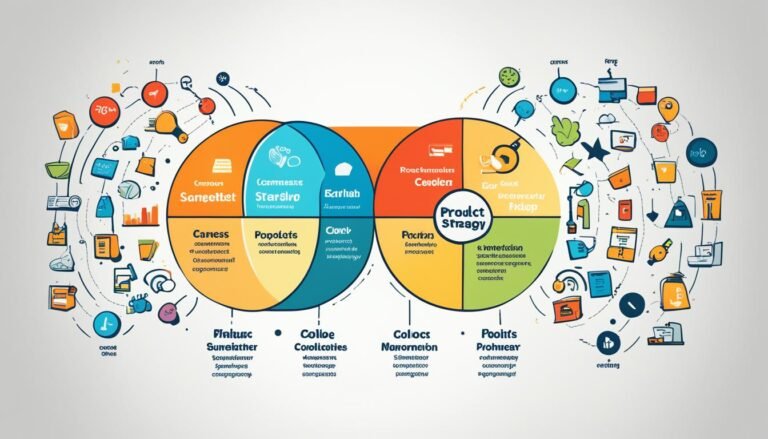The Impact of Social Media on Consumer Behavior
Did you know that 70% of Americans use social media? This shows how big of an impact social media has today. As people move online, businesses need to see how social media changes how we act and shop.
In 2014, Facebook made a big move by adding a “buy” button to ads and posts. Now, 80% of people look to friends on social media for advice when buying things. This shows how important social media is for ads and how much we trust our friends’ opinions.
Brands also use social media to make a good name for themselves and get positive word-of-mouth. They use special algorithms and social selling to reach new customers. The future looks even more exciting with things like augmented reality, making social media even more powerful in how we shop.
Key Takeaways
- 70% of Americans use social media, showing its wide influence.
- 80% of consumers look to friends on social media for buying advice.
- Brands improve their image by connecting with customers on social media.
- Social media’s “buy” buttons have changed how we buy things directly.
- Using algorithms and social selling helps brands find new customers.
Understanding Social Media Consumer Behavior
Social media consumer behavior looks at how people make choices when using digital platforms. These choices are shaped by many factors. Businesses need to keep up with new features and tech to stay ahead. This section explains why understanding social media is key for marketing strategies.
Definition and Importance
Social media consumer behavior is crucial for brands in the digital world. It includes consumer psychology, where things like likes and shares show product trust. Being open on social media builds trust, and working with influencers can help brands reach more people.
- 54% of consumers reported an uptick in social media usage over the past two years.
- 76% of consumers value prompt responses in customer service inquiries.
- 70% expect personalized responses to their needs.
Current Trends
Now, social media trends show more use of tech like augmented reality for better customer interaction. User-generated content (UGC) is key for trust and loyalty. Companies use social listening tools to understand what people think and shape their plans.
“89% of consumers are influenced by online reviews in their purchasing decisions, showcasing the strong impact of social media on consumer behavior.”
Future Predictions
The future of social media and consumer behavior will change fast. Social media trends will keep evolving, making FOMO a big factor in buying decisions. By 2027, US social commerce sales per buyer could hit $1.224 billion. Companies that connect with consumers on social platforms could see a 20-40% revenue boost. Knowing how people think and using augmented reality will be key to success.
Social Media Marketing and Consumer Psychology
Social media marketing meets consumer psychology by using special triggers. These triggers make people act in certain ways. Brands use this to make content that grabs attention and gets people to take action.
Psychological Triggers
Triggers in social media include scarcity, social proof, and reciprocity. Scarcity makes people act fast to not miss out on deals. Social proof shows that many people like a product, making others trust it more.
Reciprocity makes people do nice things for brands that give them value. For example, free trials or special content.
These triggers work well, turning people into customers or even fans. A Hubspot report found 71% of people buy things because of social media. This shows how well these marketing methods work.
Behavioral Responses
People react quickly to social media marketing. In the US, adults spend 38 minutes a day on Facebook. Young people aged 16-24 spend three hours on social media. This gives brands a chance to connect with them.
Brands with a strong social media presence see a 32% increase in sales. This is because they meet what customers expect. Also, being active on social media makes 80% of users more loyal to a brand.
Behavioral marketing helps businesses reach more people and gain trust. By engaging with customers in a thoughtful way, brands can build lasting relationships.
Influencer Marketing and Its Effectiveness
Influencer marketing has changed the way we market online. It’s now a big deal, worth about $21.1 billion in 2023. This shows it’s a powerful way to make brands more credible and get people to buy things.
Influencers are key to this success. They tell stories and share content that makes products seem appealing. This helps guide people from just learning about a product to actually buying it. For example, 31% of people find new products through influencers.
Being real is what makes influencers so important. Most people trust what influencers say more than what brands say. This is because influencers share real stories and experiences. This helps build strong connections with their followers, which can really influence what people decide to buy.
Consumer Trust and Authenticity
Trust is key in influencer marketing. When people trust a brand, they’re 53% more likely to buy from it and twice as likely to stay loyal. Influencers play a big part in building this trust with their honest reviews.
Choosing the right influencers is crucial. Brands should look at their niche, who they reach, and how engaged their followers are. Most people prefer influencers who are relatable and know their stuff over famous ones. This makes marketing more effective and builds trust in the brand.
It’s important to keep an eye on how well influencer campaigns are doing. A study found that businesses make about $5.20 for every $1 they spend on influencer marketing. This shows it’s a good investment.
The Impact of Social Media on Consumer Behavior
Social media changes how people find and connect with brands. Platforms like Facebook and Instagram lead this change. Seventy percent of users are likely to click on ads in their feeds. Facebook and Instagram get the most ad clicks, at 38% and 37% each.
Companies are moving from old-school selling to social selling. They use social media to target ads to specific people. This makes ads more relevant, which boosts engagement and sales.
In Thailand, social media use jumped from 18 to 32 hours a week from 2015 to 2018. Online spending almost doubled. Seeing others use products makes people more likely to buy them on the spot.
Ads that let people interact, like polls and quizzes, get more attention. They make people more aware of brands. Social media helps businesses see how well their ads are doing and what people like.
Ads on social media keep talking to customers over time. This helps build loyalty and support for brands. Following the rules and being honest is key to keeping trust with customers.
How people act is always changing with new social media features. Tools that listen to what people say help businesses make better ads. Social media is key for finding new products and changing how people see things online.
Brand Engagement on Social Media
Creating a strong brand on social media platforms means more than just selling. It’s about building real connections. Brand Advocates are key here. They are loyal fans who share their love for a brand online. This sharing helps the brand grow and can even make people more likely to buy things.
Social media platforms let brands talk directly to their fans through comments and posts. This builds a strong bond between the brand and its customers. Being open and honest is also important. Good reviews on sites like Yelp can bring in new fans, but ignoring bad feedback can hurt a brand’s image.
“Social proof” is key in making people buy things. People often check out what others say before they decide to buy.
Targeted ads on social media platforms use info on users to help brands sell more. These ads show up based on what people like and do online. This makes sure brands reach the right people with the right message.
Social media ads also let brands see how well they’re doing and change their plans to get better results. Ads that feel personal can make people more interested in a brand. This helps make the consumer brand relationship stronger.
In short, social media platforms are vital for marketing today. By using these platforms well, brands can get noticed, keep customers coming back, and build strong bonds with their audience. This can turn customers into Brand Advocates.
User-Generated Content and Its Influence
User-Generated Content (UGC) is a big deal in today’s digital marketing. It helps brands connect with people in a real way. About 54% of people on social media share their thoughts on products and brands.
Creating Authentic Connections
Brands that use UGC well get real endorsements from their audience. Many people look to social media for advice on what to buy. They trust real customer reviews more than ads.
Sharing stories through branded hashtags helps brands build a community. Emotional stories get more attention and engagement. UGC posts get 28% more likes than regular brand posts.
Building Community Trust
UGC is seen as reliable and honest, which builds trust in a community. Most millennials and baby boomers trust UGC to show how good a brand is. It also helps them decide what to buy.
Campaigns with UGC get 50% more engagement and keep people on websites longer. For shoppers, UGC can increase buying by 9.2%. This shows how UGC can make buying decisions better and build trust in a brand.
Using influencers with UGC is also a big trend. It helps brands connect better with their audience. As brands use UGC, focusing on real customer interactions is key to success and loyalty.
The Role of Online Communities
Online Brand Communities have grown a lot in the last ten years. This is thanks to social media platforms like WhatsApp, Instagram, and Facebook. Social media marketing (SMM) is key for companies wanting to stand out online.
Online Brand Communities are great for building Community-Driven Engagement. People like to connect and share in these online spaces. This creates a community feel that helps brands by building customs and a shared identity.
Social Networking platforms are perfect for sharing content, working together, and talking. These are crucial for making brands known and building loyalty. Companies love these interactions because they get quick feedback from customers. This makes customers feel important and more connected to the brand.
Brand communities are also places where people can find resources and guides. They help customers make better choices by letting them interact with the brand and others. This interaction is key for making informed decisions.
Through Community-Driven Engagement, brands can boost their trust and credibility. By hosting special events, offering rewards, and letting members help manage the community, brands create a strong sense of belonging. This not only increases brand support but also builds lasting loyalty among customers.
Data Analytics and Consumer Insights
In today’s digital world, data analytics has changed how businesses understand and react to what customers do. It turns raw data into useful Marketing Insights.
Using Consumer Data Analytics, companies can better track and understand how people behave. This helps them know what customers like and need. It also helps make marketing plans that hit the mark.
Tracking Consumer Behavior
With tools for analyzing feelings, businesses can keep an eye on how customers feel right now on social media. This means they can quickly answer to what people say. Social listening lets companies keep up with industry trends, what competitors do, and what customers want by looking at what people talk about.
- Sentiment Analysis: Real-time tracking of consumer sentiments on social media.
- Social Listening: Monitoring market demands through industry keywords analysis.
- Predictive Analytics: Anticipating future trends and consumer behaviors.
Network analysis finds influencers and important people in social media. This helps brands see how their marketing moves affect people. Machine learning looks at pictures on social media to spot objects, feelings, and logos. This gives deeper insights into how people see brands.
Data-Driven Marketing Strategies
Companies that use data to guide their marketing get more customer involvement and loyalty. With prescriptive analytics, marketers get clear advice to make their campaigns better. This means their messages connect well with the right people.
- Prescriptive Analytics: Provides actionable insights for campaign optimization.
- Personalized Marketing: Tailored promotions boost engagement and conversions.
- Predictive Analytics: Uses past data to guess future trends and behaviors.
Looking at what competitors do on social media shows their moves and where they’re missing out. Using customer insights helps build trust and good word-of-mouth. This makes 85% of businesses see the value in using Consumer Data Analytics to know their customers better.
eCommerce Trends Driven by Social Media
Social media has changed the way we shop online. It has brought new trends that match how people shop today. Social commerce is a big change, letting people buy things right on social media. Now, with features like shoppable posts and in-app checkout, shopping on social media is easier than before.
Social Commerce
Social commerce is changing how we connect with brands. By early 2023, the social commerce market was worth about $585 billion. It’s expected to go over $2 trillion by 2028. This growth shows how big a role social media plays in what we buy.
More than half of social media users look for products on these platforms. About 30% even buy things directly through social media. This is a big chance for brands to make buying easier and connect with customers directly.
Live Shopping Experiences
Live shopping is becoming more popular in social commerce. It lets people interact with products live, making shopping fun and engaging. AR and VR make these experiences even better, giving shoppers something traditional shopping can’t offer.
Live shopping is set to help US social commerce sales double by 2027. Retailers are getting better at using these trends to stay competitive. They’re using data to make shopping personal and working with influencers to reach more people.
By following these social media shopping trends, businesses can stay ahead. They can meet what customers want by using data, watching social media closely, and working with influencers. This helps them get more people to buy from them.
Source Links
- Council Post: How Social Media Impacts Consumer Buying
- How does social media influence consumer behavior? – Clootrack
- The impact of social media on consumer behaviour in e-commerce
- How Social Media Impacts Consumer Behavior
- 6 ways social media impacts consumer behavior
- "The Social Shift: Understanding the Impact of Social Media on Consumer Behavior"
- Social Media Marketing and Consumer Psychology – Enhelion Blogs
- The Impact of Social Media Marketing on Consumer Engagement in Sustainable Consumption: A Systematic Literature Review
- The impact of influencer marketing on consumer behavior and purchase decisions
- Understanding the Impact of Reach and Influencers
- How Social Media Influencers Shape Consumer Buying Behavior?
- The Dark Side of Social Media: Content Effects on the Relationship Between Materialism and Consumption Behaviors
- The Impact of Social Media Advertising on Consumer Behavior
- The Impact and Mechanics of Social Media on Consumer Behavior
- The Impact of Social Media on Consumer Behavior and Market Trends – Saeed Royande
- The Psychology Behind User-Generated Content
- The Evolution of UGC and Its Impact on Brand Engagement
- Frontiers | The Influencing Mechanism of Interaction Quality of UGC on Consumers’ Purchase Intention – An Empirical Analysis
- Frontiers | Role of Social Media Marketing Activities in Influencing Customer Intentions: A Perspective of a New Emerging Era
- The Impact of Online Communities on Consumer Behavior
- Our take on Consumer Insights from Social Media, A catalyst for business growth.
- Contents
- The Influence of Social Media on the Retail Industry
- The Rise of Social Commerce: A New Era in Online Shopping
- The Changing Truths About Social Media and Consumer Behavior







